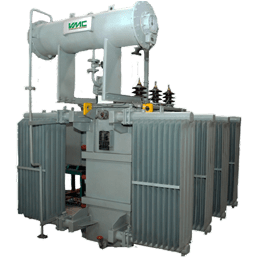Table of Contents
ToggleScott Connection of Transformer
The Scott connection, also known as the Scott-T transformer connection, is a circuit that enables the conversion of:
Three-phase (3φ) electric power to two-phase (2φ) electric power
Two-phase electric power to three-phase electric power
This conversion is achieved by connecting two single-phase transformers in a specific configuration. The Scott connection offers a balanced load distribution across the phases of the source.
A Scott-T transformer (also called a Scott connection) is a type of circuit used to derive two-phase (2-φ) current from a three-phase (3-φ) source or vice-versa. The Scott connection evenly distributes a balanced load between the phases of the source.
Component of Scott-T Transformer
The Scott connection utilizes two transformers:
- Main Transformer (T1): This is a center-tapped transformer with a 1:1 ratio.The center-tapped side signifies that the transformer has a winding with a mid-point connection.
- Teaser Transformer (T2): This transformer has a ratio of √3/2 (approximately 86.6%).
Diagram of Scott Connection of Transformer

The Scott connection can be visualized through the following diagram: In the diagram:
The center-tapped side of T1 connects between phases B and C of the three-phase system.
The center tap of T1 connects to one end of the lower turn count side of T2.
The other end of T2’s lower turn count side connects to the remaining phase (phase A).
The other sides of both transformers (T1 and T2) connect directly to the two output phases of the two-phase system.
Working Principle
The Scott connection functions by leveraging the voltage and phase shift properties of the transformers. The center-tapped transformer (T1) splits the three-phase voltage into two components with a 120-degree phase shift.
The teaser transformer (T2) introduces a √3 voltage ratio and a 30-degree phase shift, resulting in the creation of a two-phase system with a 90-degree phase difference between the phases.The Scott connection functions by leveraging the voltage and phase shift properties of the transformers.
The center-tapped transformer (T1) splits the three-phase voltage into two components with a 120-degree phase shift. The teaser transformer (T2) introduces a √3 voltage ratio and a 30-degree phase shift, resulting in the creation of a two-phase system with a 90-degree phase difference between the phases.
Application of Scott-T Transformer
The Scott connection finds applications in various scenarios, including:
Connecting a three-phase system with a two-phase system for power exchange.
Operating single-phase loads, such as electric trains, from a balanced three-phase supply.
Supplying power to two single-phase electric furnaces simultaneously from a threephase supply
Frequently Asked Question (FAQ)
What is a Scott transformer connection?
The Scott transformer connection is a special arrangement of two single-phase transformers used to convert a three-phase supply into a two-phase supply or vice versa. It was invented by Charles F. Scott in 1895 and is commonly employed in applications requiring the conversion of three-phase power to two-phase power, such as in railway electrification systems.
How does a Scott transformer connection work?
In a Scott transformer connection, two single-phase transformers are connected together in a specific configuration. One transformer, known as the main transformer, has a primary winding connected directly to all three phases of the three-phase supply. The secondary winding of this transformer is center-tapped, creating two output voltages. The second transformer, known as the teaser or auxiliary transformer, has its primary winding connected in series with the secondary winding of the main transformer. The secondary winding of the teaser transformer is then connected across two phases of the three-phase supply. This arrangement produces two output voltages with a 90-degree phase shift between them.
Where is the Scott T transformer connection commonly used?
It’s commonly used in applications like railway electrification systems and industrial processes needing balanced two-phase power.
What are the advantages of the Scott T transformer connection?
It offers conversion between three-phase and two-phase power without additional phase-shifting equipment and allows precise control over voltage and phase relationships between the output phases.
Are there any drawbacks to using a Scott T transformer connection?
Yes, drawbacks include increased complexity, potential for voltage and phase imbalances, and higher costs compared to simpler transformer configurations.
Are there any limitations or drawbacks to using a Scott transformer connection?
While the Scott transformer connection offers several advantages, it also has some limitations and drawbacks, including:
- Increased complexity compared to conventional transformer connections, which may require additional engineering expertise and maintenance.
- Limited availability of off-the-shelf transformers designed specifically for Scott connection applications, which may require custom manufacturing.
- Higher cost compared to alternative methods of converting between three-phase and two-phase power.
- Potential for voltage and phase imbalances between the two output phases, particularly under unbalanced load conditions.


Pingback: Hot spot formation in Transformer - Electricalsphere
Your article helped me a lot, is there any more related content? Thanks! https://accounts.binance.com/register-person?ref=IXBIAFVY